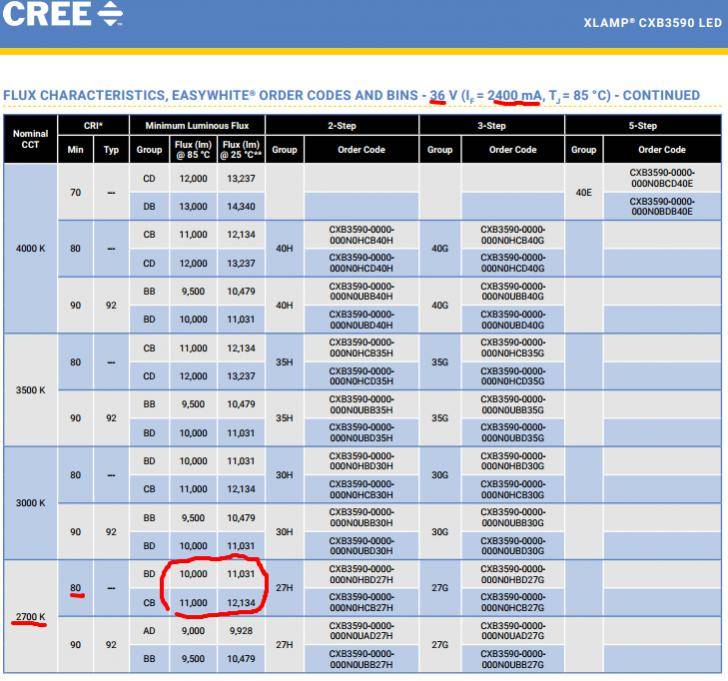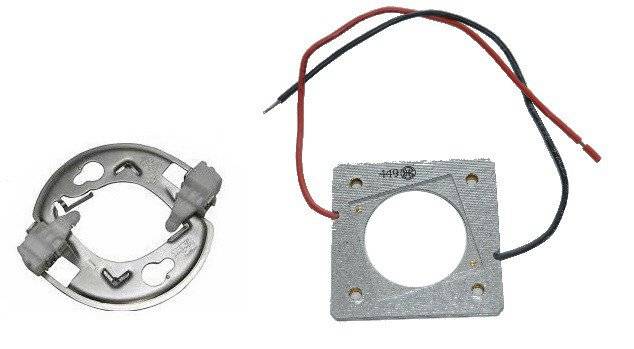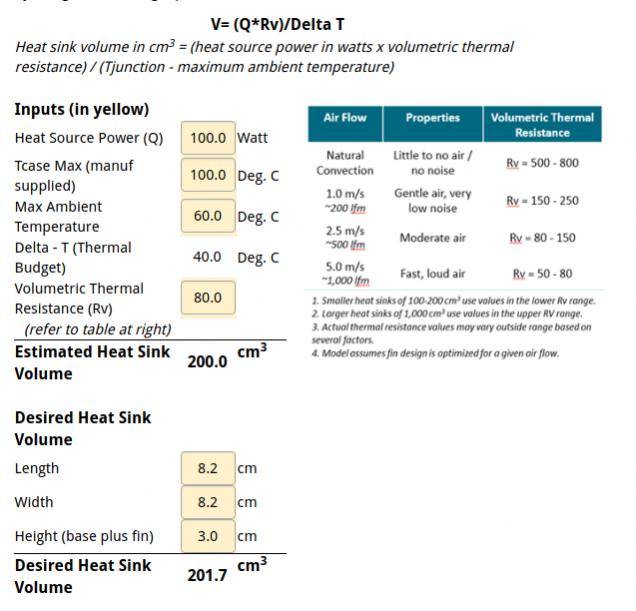You are using an out of date browser. It may not display this or other websites correctly.
You should upgrade or use an alternative browser.
You should upgrade or use an alternative browser.
DIY LED CXB3590 2700K 32VDC X 6 (grow light)
- Thread starter acespicoli
- Start date
12,134 minimum lumen output (@2400mA, 25 degrees C)
Output depends on operating temperature and amps
Conservatively im probably getting 9,000 lumens or candle power each COB @ 2100mA
Im also gonna have the beam focused from 115 degrees to 60 degrees so the PAR at canopy level will be higher than expected

Output depends on operating temperature and amps
Conservatively im probably getting 9,000 lumens or candle power each COB @ 2100mA
Im also gonna have the beam focused from 115 degrees to 60 degrees so the PAR at canopy level will be higher than expected
Last edited:
Hi everyone,
Its been awhile since my last update, I have had some problems with the light connectors. Currently reworking the light as I post this update. Trying to go for more of a track lighting type fixture...

I prefer the square connectors that screw down,
The round "ideal" connectors would lift off the contacts when the beams were articulated.
Its been awhile since my last update, I have had some problems with the light connectors. Currently reworking the light as I post this update. Trying to go for more of a track lighting type fixture...
I prefer the square connectors that screw down,
The round "ideal" connectors would lift off the contacts when the beams were articulated.
Last edited:
420empire
What was the question you had ?
What was the question you had ?
My latest LED works well on veg x 6
CREE CXB3590 3500K COB LED $30.00
Mean Well HBG-100-48A driver $38.90
IDEAL 50-2303CR $2.50
IDEAL 50-2300AN (CXB3590) $1.00
LEDIL ANGELINA REFLECTOR $5.50
UNIVERSAL WIRE CONNECTOR $5.00
3-PRONG US POWER CORD (6') $3.00
What was roughly the price for the heatsink? Heatsinks are the hardest part to find for me at a reasonable price.
Apart from this, how did you calculate the heatsink size? Is it per W?
Tks
140mm were recommended to me by the supplier they are kinda small
larger heat sinks would have been better
Definately look into the double ended LEC light emitting ceramic or ceramic metal halide
For less money you could have more light and close to the same operating costs
If you gonna run a scrubber for odor then moving the extra heat is not a issue most likely
Your welcome Kosh best of luck to you on your new build
Plan on one LED covering a area of 2x2 feet also they run a little warm (nothing like a HPS)
So you may want the heatsinks on the outside or fan cooled in a cabinet
I would think a micro grow one COB would be enough ?
This build was for a 4x4 flower area with separate veg and clone
Dim is possible with the C2100B driver
If your going to use it in a low ceiling area dimmable would be preferable for young light sensitive plants and or clones
So this might work well for you!
CREE CXB3590 2700K
Typical Forward Voltage : 36V
Max Drive Current : 3600mA
Minimum Lumen Output (@2400mA, 25°C) : 12,134
https://www.cree. com/led-components/media/documents/ds-CXB3590.pdf
HLG-240H-C2100B (This driver will auto adjust to needed voltage)
Output Voltage (DC) : 59-119V (2-3 X 36V COBs)
Max Output Current : 2100mA (This should be even across all COB's with dimming)
Input Voltage (AC) : 90-305VAC
AC Current : 2.5A/115VAC, 1.3A/230VAC
Dimming Signal : 0-10V Analog, 10V PWM, Resistance
Efficiency : 93.5%
https://www.meanwell. com/webapp/product/search.aspx?prod=HLG-240H-C
Page 4 covers 3 in 1 dimming
https://www.rapidled. com/cased-potentiometer-with-knob/
Note: You always wanna run these less than max for longevity of components
https://en.wikipedia. org/wiki/Series_and_parallel_circuits < links intentionally disabled
In a series circuit, the same amount of amperage from the power source flows through each load. The Voltage in a series circuit is divided up across all of the loads.
Feel free to contact me if you need some design questions answered I might be able to help.
These are a bit daunting to learn the ins and outs, they are very simple to use and more rugged than expected.
There are some online heatsink calculators to figure the size of heat sink you would need

These are the manufacturer max operating temps

Formulas to Calculate
https://www.inchcalculator. com/ohms-law-calculator/
Plan on one LED covering a area of 2x2 feet also they run a little warm (nothing like a HPS)
So you may want the heatsinks on the outside or fan cooled in a cabinet
I would think a micro grow one COB would be enough ?
This build was for a 4x4 flower area with separate veg and clone
Dim is possible with the C2100B driver
If your going to use it in a low ceiling area dimmable would be preferable for young light sensitive plants and or clones
So this might work well for you!
CREE CXB3590 2700K
Typical Forward Voltage : 36V
Max Drive Current : 3600mA
Minimum Lumen Output (@2400mA, 25°C) : 12,134
https://www.cree. com/led-components/media/documents/ds-CXB3590.pdf
HLG-240H-C2100B (This driver will auto adjust to needed voltage)
Output Voltage (DC) : 59-119V (2-3 X 36V COBs)
Max Output Current : 2100mA (This should be even across all COB's with dimming)
Input Voltage (AC) : 90-305VAC
AC Current : 2.5A/115VAC, 1.3A/230VAC
Dimming Signal : 0-10V Analog, 10V PWM, Resistance
Efficiency : 93.5%
https://www.meanwell. com/webapp/product/search.aspx?prod=HLG-240H-C
Page 4 covers 3 in 1 dimming
https://www.rapidled. com/cased-potentiometer-with-knob/
Note: You always wanna run these less than max for longevity of components
https://en.wikipedia. org/wiki/Series_and_parallel_circuits < links intentionally disabled
In a series circuit, the same amount of amperage from the power source flows through each load. The Voltage in a series circuit is divided up across all of the loads.
Feel free to contact me if you need some design questions answered I might be able to help.
These are a bit daunting to learn the ins and outs, they are very simple to use and more rugged than expected.
There are some online heatsink calculators to figure the size of heat sink you would need
These are the manufacturer max operating temps
Formulas to Calculate
https://www.inchcalculator. com/ohms-law-calculator/
Last edited:
More Pin Fin heatsink info
Φ120mm*H70mm(for 40-50W):
Φ133mm*H70mm(for 50-60W):
Φ150mm*H70mm(for 60-70W):
Φ160mm*H70mm(for 75-85W):
Φ180mm*H70mm(for 95-105W):
Φ120mm*H70mm(for 40-50W):
Φ133mm*H70mm(for 50-60W):
Φ150mm*H70mm(for 60-70W):
Φ160mm*H70mm(for 75-85W):
Φ180mm*H70mm(for 95-105W):

Frontiers | Cannabinoids and Terpenes: How Production of Photo-Protectants Can Be Manipulated to Enhance Cannabis sativa L. Phytochemistry
Cannabis sativa L. is cultivated for its secondary metabolites, of which the cannabinoids have documented health benefits and growing pharmaceutical potentia...
Daily light integral - Wikipedia
The equation for converting Photosynthetic Photon Flux Density (PPFD) to DLI, assuming constant PPFD, is below.[1]
where
Light-hours is the number of hours in a day active photons are delivered to the target area, measured in hours.
Note that the factor 3.6·10−3 is due to the conversion factors coming from μmol being converted to mol and the unit of hours (from Light-Hours) being converted to seconds.
Last edited:

Photosynthetically active radiation - Wikipedia
 en.wikipedia.org
en.wikipedia.org

Photosynthetically active radiation - Wikipedia
| Unit | Definition |
|---|---|
| Photosynthetic photon flux (PPF) | Photosynthetic photon flux (PPF) micromoles per second (μmol·s−1) |
| Photosynthetic Photon Flux Density (PPFD) | Photosynthetic photon flux (PPF) micromoles per square meter per second (μmol·m−2·s−1) |
| Yield photon flux (YPF) | Yield photon flux (YPF) micromoles per second (μmol·s−1) |
| Yield photon flux density (YPFD) | Yield photon flux (YPF) micromoles per square meter per second (μmol·m−2·s−1) |

Lumen (unit) - Wikipedia
SI photometry quantities
| Quantity | Unit | Dimension [nb 1] | Notes | ||
|---|---|---|---|---|---|
| Name | Symbol[nb 2] | Name | Symbol | ||
| Luminous energy | Qv[nb 3] | lumen second | lm⋅s | T⋅J | The lumen second is sometimes called the talbot. |
| Luminous flux, luminous power | Φv[nb 3] | lumen (= candela steradian) | lm (= cd⋅sr) | J | Luminous energy per unit time |
| Luminous intensity | Iv | candela (= lumen per steradian) | cd (= lm/sr) | J | Luminous flux per unit solid angle |
| Luminance | Lv | candela per square metre | cd/m2 (= lm/(sr⋅m2)) | L−2⋅J | Luminous flux per unit solid angle per unit projected source area. The candela per square metre is sometimes called the nit. |
| Illuminance | Ev | lux (= lumen per square metre) | lx (= lm/m2) | L−2⋅J | Luminous flux incident on a surface |
| Luminous exitance, luminous emittance | Mv | lumen per square metre | lm/m2 | L−2⋅J | Luminous flux emitted from a surface |
| Luminous exposure | Hv | lux second | lx⋅s | L−2⋅T⋅J | Time-integrated illuminance |
| Luminous energy density | ωv | lumen second per cubic metre | lm⋅s/m3 | L−3⋅T⋅J | |
| Luminous efficacy (of radiation) | K | lumen per watt | lm/W | M−1⋅L−2⋅T3⋅J | Ratio of luminous flux to radiant flux |
| Luminous efficacy (of a source) | η[nb 3] | lumen per watt | lm/W | M−1⋅L−2⋅T3⋅J | Ratio of luminous flux to power consumption |
| Luminous efficiency, luminous coefficient | V | 1 | Luminous efficacy normalized by the maximum possible efficacy | ||
| See also: |
6" Double Ended Air Cool Reflector: US $89.99 Free S&H ebay
(CERAMIC AND METAL INSULATORS MANDATORY) NO THERMAL PLASTICS FROM CHINA
- Size: 24 x 21 x 9
- Lamp Compatibility: MH/HPS 250W/400W/600W/1000W
- Galvanized Steel Hood
- Socket type: Double Ended Socket
- Air Duct Size: 6"
- Industry Standard S-plug
- Pre-installed ceramic socket
- Flip down tempered glass
- 15' Heavy duty wire cord
- Metal Hangers Included
The Phantom II Digital Ballast 120/240V MIXED REVIEWS....
Philips Master GreenPower Plus 1000W de Lamp
Ushio Double Ended Lamp - AHS-DE 1000W - Pro-Plus
Last edited:
Spectra of the best 1000w de lamps
Okay, so here the test results for the best 1000w DE lamp test. Looking at the spectra of these different light bulbs you'll notice that they all overlap each other extremely well. The only time you can actually notice that there's any difference in the spectra of these grow lamps is the minor differences in intensity between them at different wavelengths. Since all HPS lamps have a very similar chemical makeup (sodium and other trace elements), we expect them to be at least somewhat similar, so no surprise here.
PAR charts over 3' x 3' of best 1000w de lamps
Now you can see you know how we did our testing. We essentially put each grow lamp above our 3 ft x 3 ft footprint, and we went out to3 ft x 3 ft just because we wanted enough points to get a statistically significant reading of the photosynthetically active radiation (PAR) that the light bulbs are giving off. PAR is effectively the intensity between 400 to 700 nanometer light wavelengths, which is the range of the wavelength that plants use best to photosynthesize. So in taking the sum of the intensities and all these points within a three by three area we were able to glean quite a bit of statistical data.
bar graphs of light intensity of 1000w DE lamps
So let me pull it up right now, so here's a chart that shows off you know, what we think is probably the best number to focus on to figure out what lamp really did best in this test which is the 'Sum of all PAR over 3' x 3' Footprint', which means taking every point that we measured and adding them together. The 1000w DE lamp that performed best in testing was the light that turned out to give us the most amount of light using the same ballast and reflector was the Philips Green Power 1000 watt DE HPS.Our hypothesis was that the Philips 1000w DE lamp would probably do best because we've heard from other lighting manufacturers who have done similar testing using equipment that's far superior to ours--such as goniophotometers--saying that the Phillips DE, with some of its patented ignition technology, is producing the best 1000w DE lamp out there.

statistics of the best 1000w de lamps
So we recorded the total par of 18,852 and we some of them up, but that said there are four lights that we felt performed very well. The Philips Green Master Power 1000 watt DE HPS being number one and then it looks like the Gavita Pro Plus 1000w DE HPS Lamp and the Ushio DE Enhanced Performance Pro-Plus HPS 1000w Lamp, and then the Genesis. All four of those 1000w DE lamps are actually within about 1.5 percent of each other. We're not talking about drastic differences--I would consider all those bulbs very good. If you want the best bulb out there, it's the Phillips 1000w.
Jumping into the lights that we're not in the top four, one of the one of the ones that we were hoping was going to be up there Hortilux 1000w DE lamp. It didn't quite make it with their first DE iteration. Looking into maybe what the most bang for your buck, you may want to go with the Nanolux MaxPar DE HPS 1000W Lamp. It did pretty well coming in just behind those first four, and at a cost of about two-thirds the price most the lamps on here.
Another interesting note is the difference between the best lamp and the worst lamp was about 7.4%. I would say that's definitely going to have a meaningful difference in your crop yield, especially if you're a commercial grower. In our final thoughts, it seems the differences in lamp quality is not just marketing hype. There are true differences in 1000w DE lamp performance. Think about your priorities when shopping around overall output vs budget, but if you're growing high value crops, it seems the Philips 1000w DE is going to give you the most output of your buds and flowers. Happy growing everyone.
Last edited:



